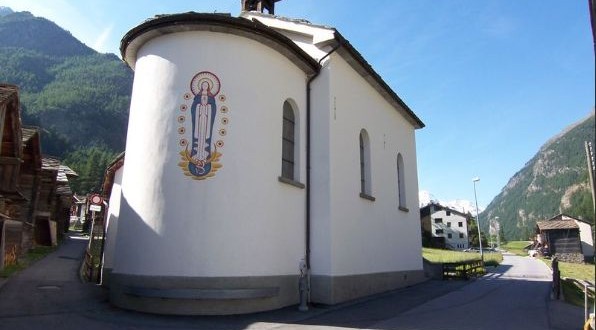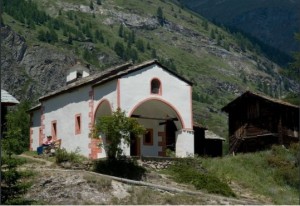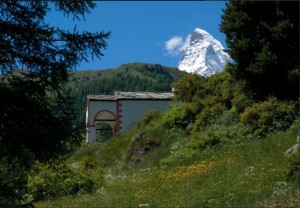Chapel in der Wildi is a striking white chapel that stands on the road running through the village of Randa. The small sanctuary is dedicated to the Virgin Mary. The chapel “in der Wildi” was built in 1882 and is dedicated to the Mother of God. It is a tall, narrow building whose semi circular choir reveals its 19th century origins. An open roof turret with wide outspreading pyramid shaped roof sections made from shingles sits on the stone tiled roof above the curve of the choir. The simple rectangular portal framed with granite on the gable front is shaded by a canopy. Both externally and internally, the chapel reveals the style of the renovation of 1954. On the inside, the nave is divided into two cross-vaulted bays by a transverse arch on pilasters. The top of the choir arch is decorated with a crowned Maria monogram bordered by roses, clouds and rays of light. The large arched windows are decorated with pale violet and yellow glass. The altar was redesigned in 1882, reusing parts of an altar by Johann Ritz. In 1954, the altarpiece was replaced by an Immaculata. The bell, with a diameter of 30.7 centimeters is inscribed with the year 168 and its only other decoration is a Latin cross on one side, formed of flowers.
Blatten chapel or Maria Rosenkranzkonigin stands on a small rise, on the Blatten or a rock ledge in the eponymous hamlet below Furi, at an altitude of 1740 meters. This chapel is one of the best known in Zermatt, and is clearly visible from the gondolas of the Matterhorn Express. The baroque chapel with recessed choir was built in 1640. The entrance was originally located on the north side, where its outlines are still clearly visible. It was moved to the east side in 1704 and protected with a porch, a massive pillared arcade. When the French overran the village in 1798, the inhabitants of Blatten and Zum See are said to have hidden their modest weapons in the attic of this porch. The interior and exterior of the church was renovated in 1983, and the red paintwork was applied. Until the 20th century, the faithful continued to make pilgrimages to Blatten in two processions. The so-called “Long Procession”, with vespers not far from the chapel, led via Moos back to the village church.
The stone-vaulted chapel is dedicated to Mary, Queen of the Rosary. The small altarpiece from the early baroque period, a one-level retable, shows the Mother of God with a nimbus whose points end is stylized roses. The five angels’ heads correspond to the five laws and the fifteen roses to the secrets of the rosary. The altar is crowned with a simple statue of St.Joseph. The original Madonna is missing but it was replaced long ago by a plaster figure. The Zermatt priest Oswald Perren made the chapel a gift of its current Madonna from southern Italy. The Mother of God is carrying the Child Jesus on her arm. A sturdy choir grille protects the altar and the statue from theft and destruction, while the leaded glass windows let sun and light into the room. A simple Stations of the Cross without inscriptions decorated the chapel nave. It is right beside the Furi-Zermatt ski piste for easy access.



